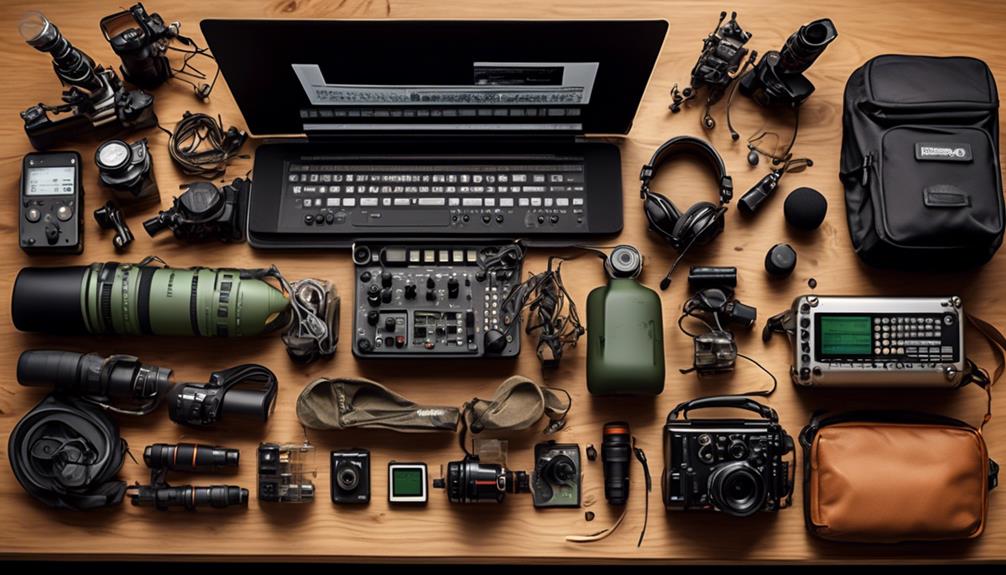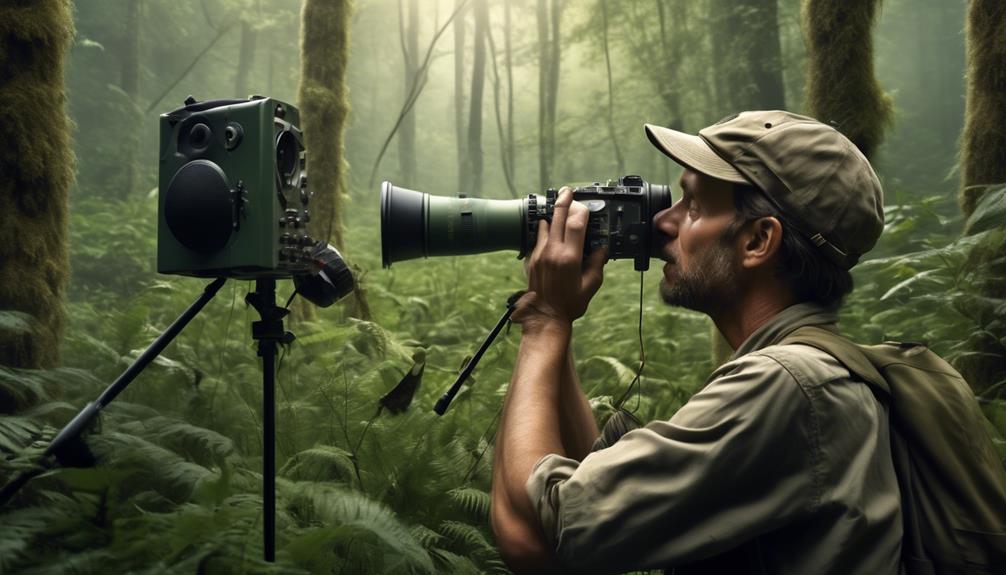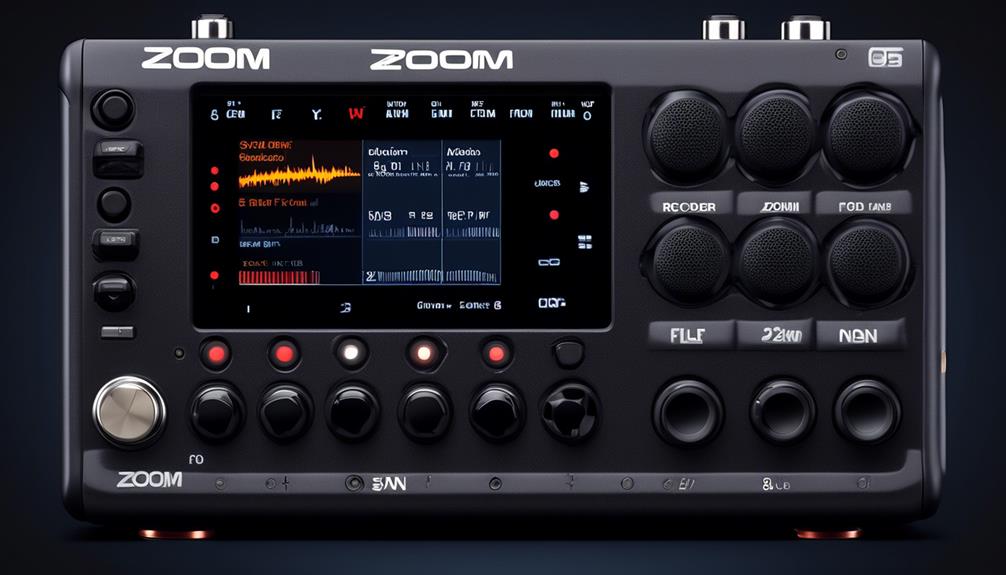So, you believe that all a field recordist does is roam around with a sophisticated recorder, pushing a few buttons every now and then? Think again.
The role of a field recordist extends far beyond just capturing sounds. From the essential equipment they use to the techniques they employ, the challenges they face, and the advantages of their work, there's a whole world of intricacies to explore.
Join us as we unravel the fascinating world of field recording and discover the artistry and expertise behind this often overlooked profession.
Key Takeaways
- Field recording involves capturing audio recordings outside of traditional studio environments using high-quality equipment and advanced techniques.
- The primary purpose of field recording is to capture natural and human-produced sounds in various environments, serving as a resource for sound designers, filmmakers, and other creative professionals.
- Field recording contributes to the advancement of sound design and engineering, documenting and preserving sounds for artistic or scientific purposes, and studying and understanding natural and human-made sounds.
- Field recording requires essential equipment such as audio recorders, headphones, microphones, wind protection, and specialized techniques like A/B, XY, and M/S to capture a wide stereo image and control ambiance levels. It also involves considering frequency response and creative approaches to microphone placement and sound diffusion.
The Role of a Field Recordist
Field recordists play a crucial role in capturing audio recordings produced outside of traditional studio environments. They utilize high-quality equipment and advanced recording techniques to capture a wide range of sounds. In the realm of field recording, the primary objective is to capture the natural sounds of the world and human-produced sounds in various environments. These environments can range from serene natural landscapes to bustling urban settings.
The recordings captured by field recordists are not only authentic but also serve as a vital resource for sound designers, filmmakers, and other creative professionals. The work involves using specialized recording equipment, including professional recorders, microphones, and pre-amplifiers, to ensure the highest possible audio quality.
Field recordists employ a range of recording techniques such as A/B, XY, and M/S to capture a wide stereo image and control ambiance levels during the recording or editing process. These techniques allow them to capture the essence of the environment and provide a rich and immersive experience for the audience.
Furthermore, as field recordists, they are continuously exploring and developing new techniques in field recording. This includes creative microphone placement, sound diffusion, and individual approaches that expand artistic expression. The recordings not only serve as a documentation of the world but also contribute to the advancement of sound design and engineering. They offer unique career opportunities in various media and related fields.
Essential Equipment for Field Recording

When embarking on field recording, it's imperative to equip oneself with essential tools to ensure the capture of high-quality audio recordings. Here are the essential equipment for field recording:
- Audio Recorder (Field Recorder): A reliable field recorder is the backbone of sound recording in the field. It should have high-quality preamps, durable build, and the ability to capture in various file formats.
- Headphones: Quality headphones are crucial for monitoring and ensuring the integrity of the recorded audio. They help in identifying any issues with the recording, such as unwanted noise or distortion.
- Additional Microphones: Depending on the specific requirements of the recording project, having a variety of microphones such as shotgun, lavalier, or stereo pair can help capture diverse and unique sounds.
- Wind Protection (Windshields and Blimps): When recording outdoors, wind protection is essential to minimize unwanted wind noise. Windshields and blimps are designed to shield the microphones from wind, ensuring clean and clear recordings.
In the field recording industry career roles, having the right equipment is crucial for capturing ambient sounds and recording sound effects. The use of field recordings to create unique sounds requires the field recorder to be equipped with essential equipment for a successful recording session.
Techniques Used in Field Recording
Utilizing advanced recording techniques and specialized equipment, field recordists capture a diverse range of natural and human-produced sounds in non-studio environments. When recording ambient sounds, it's essential to consider the frequency response of the equipment used. Low frequencies, in particular, are crucial for capturing the deep rumble of thunder or the subtle rustling of leaves. To emphasize this point, consider the following table:
| Frequency Range | Sound Example |
|---|---|
| Low | Roaring thunder |
| Mid | Birdsong |
| High | Rustling leaves |
These natural sounds are often recorded for use in sound libraries, where they may be utilized in various media such as film, video games, or music production. To achieve high-quality recordings, field recordists rely on professional audio recorders and microphones, as well as accessories like windscreens and shock mounts to minimize unwanted noise. Various techniques, such as A/B, XY, and M/S, offer different approaches to capturing a wide stereo image and controlling ambiance levels. Moreover, new and creative approaches to microphone placement and sound diffusion continue to expand the artistic possibilities within the field of field recording.
Challenges Faced by Field Recordists

Faced with the challenges of limited opportunities and intense market competition, field recordists encounter significant difficulties in establishing a sustainable income solely from their craft. The world of field recording presents several obstacles that demand resilience and adaptability:
- Limited Opportunities and Market Competition: Navigating a saturated market with limited demand for niche recordings can be disheartening, leading to financial instability and doubts about the viability of a career in field recording.
- Constant Creativity and Innovation: The pressure to produce unique and high-quality recordings that stand out in a crowded field requires continuous creativity and innovation, adding to the mental and emotional strain of the profession.
- Location Limitations and Collaboration Opportunities: The inability to access diverse recording environments and collaborate with other professionals can lead to a sense of isolation and hinder the expansion of skills and opportunities.
- Financial Investment and Fluctuating Income Streams: Balancing the need for high-quality recording equipment with fluctuating income streams poses a significant challenge, often leading to financial stress and uncertainty about sustaining the desired sound quality in recordings.
These challenges underline the demanding nature of work in the field and the resilience required to thrive in the profession.
Advantages of Field Recording
Field recording offers a unique opportunity to capture authentic and diverse sounds from both natural and human environments, providing a valuable resource for various media productions and artistic endeavors. The advantages of field recording are multifaceted and encompass technical, creative, and commercial benefits.
| Advantages of Field Recording | Description |
|---|---|
| Capturing Authentic Sounds | Recording sounds in their original environments allows for the capture of unique and genuine audio, contributing to immersive and realistic soundscapes in various media productions. |
| Exploration of Recording Techniques | Field recording often involves experimenting with different recording techniques and equipment to achieve a desired frequency response, low noise, and high-quality recordings. |
| Potential for Commercialization | Field recording offers opportunities for monetization through the sale of sound effects as well as careers in audio-related fields such as music production and sound design. |
Field recording not only enables the start of making original and innovative audio content but also provides a platform for personal enrichment and creativity. With the right equipment, such as shock mounts and high-quality microphones, field recording becomes a powerful tool for capturing any type of sound. Renowned field recordist Chris Watson is a notable example of someone who has demonstrated the immense potential and value of field recording.
Frequently Asked Questions
What Does a Field Recorder Do?
We utilize high-quality equipment like professional recorders, microphones, and pre-amplifiers to capture ambient noises in wildlife and urban environments.
We overcome environmental challenges in remote locations, considering weather and sound capture techniques.
Post production work involves creative microphone placement and sound diffusion, expanding audio storytelling opportunities.
Our field recordist work entails patience, adaptability, and the ability to work in potentially dangerous locations, all to create rich stereo imagery.
How Do You Become a Field Recordist?
To become a field recordist, one needs to master various audio equipment, recording techniques, and audio editing. It involves capturing soundscapes, natural environments, wildlife sounds, and environmental sounds in remote locations.
Pursuing career opportunities in this field requires specialization and unique recordings. Constant innovation and creative microphone placement are key. Field recordists work as freelancers and may need additional income sources, but recognition and career opportunities can arise in related fields.
What Is the Difference Between Field Recording and Studio Recording?
In field recording, we require specialized equipment like portable recorders, microphones, and pre-amplifiers to capture natural ambiance, environmental sounds, and wildlife in uncontrolled environments. We face weather challenges, work in remote locations, and must master technical skills for sound isolation.
The difference from studio recording lies in the unique challenges of capturing raw, organic sounds outside of controlled environments, demanding adaptability, creativity, and precision.
Why Is Field Recording Important?
Field recording is important for capturing environmental sounds, natural ambience, wildlife audio, and cultural preservation. It documents history through soundscapes, atmospheric recordings, and location sound, contributing to acoustic ecology.
This technique is vital for maintaining a rich auditory record of our world, providing valuable resources for sound designers and preserving the natural and cultural heritage.
Field recording allows for the immersive experience of audio, enhancing the depth and realism of audio productions.
Conclusion
In conclusion, as field recordists, we're the sonic archivists, capturing the symphony of the world around us.
Just as a painter uses a canvas and brush to capture the beauty of nature, we use our recording equipment to paint a picture with sound.
Our work is a testament to the intricate and diverse tapestry of life, preserving the fleeting moments and timeless rhythms of the world for future generations to experience and appreciate.










